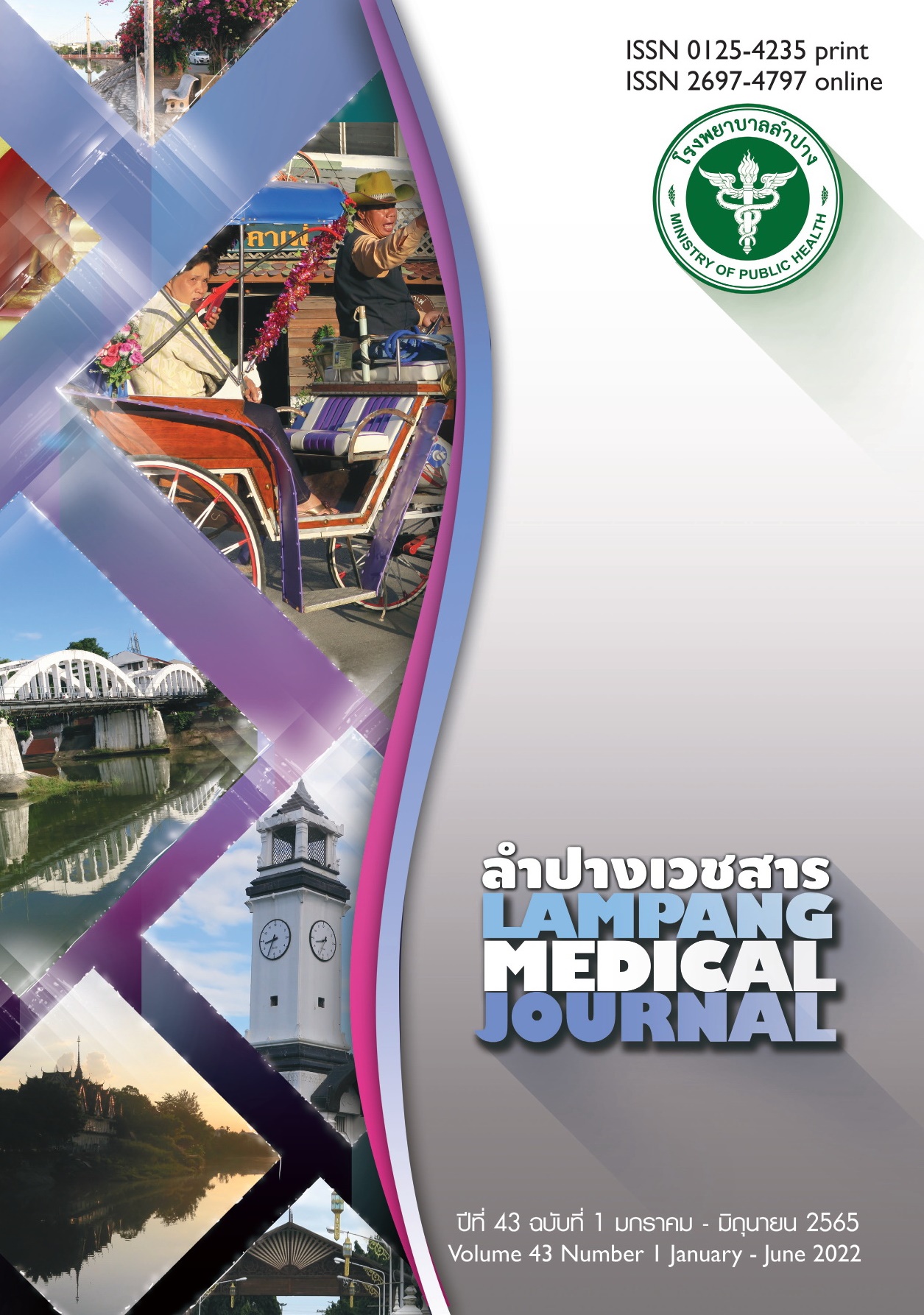Effectiveness of Pain Control in Total Knee Arthroplasty between Different Anesthetic Techniques in Phrae Hospital
Main Article Content
Abstract
Background: Anesthetic techniques in total knee arthroplasty (TKA) include general anesthesia (GA), spinal anesthesia (SA), adductor canal block (ACB), periarticular infiltration (PAI) and SA combined with intrathecal morphine (SA+MO). There is diversity of utilizing these techniques.
Objective: To evaluate the efficacy of postoperative pain control and walking ability between different anesthetic techniques used in TKA.
Material and method: A retrospective analytical study was conducted among 153 patients receiving TKA during August 2018 – July 2019 under 5 different anesthetic techniques; group 1: SA+ACB 55 cases, group 2: SA+PAI 13 cases, group 3: SA+MO 63 cases, group 4: GA+PAI/ACB 9 cases and group 5: GA 13 cases. Postoperative pain score at 2, 24, 48 hours and ability to walk with walker within 48 hours were compared between groups.
Result: The mean 2-hrs pain score in GA group was 4.5 (SD 2.2), significantly higher than group 1−4. The average 24-hrs pain score in GA group was 4.3 (SD 2.0), significantly higher than group 1, 3 and 4. At 48 hours, the mean pain
score in GA group (3.5, SD 1.3) was higher than SA+ACB (2.6, SD 0.9, p=0.035) and GA+PAI/ACB group (2.1, SD 0.6, p=0.012). The pain scores in group 1−4 were not significantly different, no matter when assessed at 2, 24 or 48 hours. Percentages of patients with satisfied walking ability in SA+ACB and SA+PAI groups were higher than those of GA+PAI/ACB and GA groups (92.7% and 92.3% vs 55.6% and 53.8% respectively, p=0.002)
Conclusion: Using PAI or ACB, combined with either SA or GA provided similar effectiveness of postoperative pain control in TKA, and not different from SA+ MO. Combination of these techniques had better results than using GA alone.
Article Details

This work is licensed under a Creative Commons Attribution-NonCommercial-NoDerivatives 4.0 International License.
บทความที่ส่งมาลงพิมพ์ต้องไม่เคยพิมพ์หรือกำลังได้รับการพิจารณาตีพิมพ์ในวารสารอื่น เนื้อหาในบทความต้องเป็นผลงานของผู้นิพนธ์เอง ไม่ได้ลอกเลียนหรือตัดทอนจากบทความอื่น โดยไม่ได้รับอนุญาตหรือไม่ได้อ้างอิงอย่างเหมาะสม การแก้ไขหรือให้ข้อมูลเพิ่มเติมแก่กองบรรณาธิการ จะต้องเสร็จสิ้นเป็นที่เรียบร้อยก่อนจะได้รับพิจารณาตีพิมพ์ และบทความที่ตีพิมพ์แล้วเป็นสมบัติ ของลำปางเวชสาร
References
Li JW, Ma Ys, Xiao LK. Postoperative pain management in total knee arthroplasty. Orthop Surg. 2019;11(5):755−61.
O’Donnell R, Dolan J. Anaesthesia and analgesia for knee joint arthroplasty. BJA Educ. 2018;18(1):8−15.
Rodgers A, Walke N, Schug S, Mckee A, Kehlet H, van Zundert A, et al. Reduction of postoperative mortality and morbidity with epidural or spinal anaesthesia:results from overview of randomized trials. BMJ. 2000;321(7275):1493.
Dimaculangan D, Chen JF, Borzio RB, Jauregui JJ, Rasquinha VJ, Maheshwari AV. Periarticular injection and continuous femoral nerve block versus continuous femoral nerve block alone on postoperative opioid consumption and pain control following total knee arthroplasty: randomized controlled trial. J Clin Orthop Trauma. 2019;10(1):81−6.
Johnson RL, Kopp SL, Burkle CM, Duncan CM, Jacob AK, Erwin PJ, et al. Neuraxial vs general anaesthesia for total hip and total knee
arthroplasty: a systematic review of comparative-effectiveness research. Br J Anaesth. 2016;116(2):163−76.
Memtsoudis SG, Cozowicz C, Bekeris J, Bekere D, Liu J, Soffin EM, et al. Anaesthetic care of patients undergoing primary hip and knee
arthroplasty: consensus recommendations from the International Consensus on Anaesthesia-Related Outcomes after Surgery group (ICAROS) based on a systematic review and meta-analysis. Br J Anaesth. 2019;123(3):269−87.
Matharu GS, Garriga C, Rangan A, Judge A. Does regional anesthesia reduce complications following total hip and knee replacement compared with general anesthesia? an analysis from the national joint registry for England, Wales, Northern Ireland and the Isle of Man. J Arthroplasty. 2020;35(6):1521−8.
Harsten A, Kehlet H, Toksvig-Larsen S. Recovery after total intravenous general anaesthesia or spinal anaesthesia for total knee arthroplasty: a randomized trial. Br J Anaesth. 2013;111(3):391−9.
Stambough JB, Bloom GB, Edwards PK, Mehaffey GR, Barnes CL, Mears SC. Rapid recovery after total joint arthroplasty using general anesthesia. J Arthroplasty. 2019;34(9):1889−96.
สตบงกช ทั่งทอง, วิทยา ประทินทอง, นงลักษณ์ มะพงษ์เพ็ง, ศิริรัตน์ แท่งทอง. ประสิทธิภาพของการฉีดยาในข้อเข่าและเนื้อเยื่อบริเวณผ่าตัดเพื่อลดอาการปวดหลังการผ่าตัดเปลี่ยนข้อเข่าเทียม. วิสัญญีสาร. 2559;42(1):11−20.
Sardana V, Burzynski JM, Scuderi GR. Adductor canal block or local infiltrate analgesia for pain control after total knee arthroplasty: A systemic review and meta-analysis of randomized controlled trial. J Arthroplasty. 2019;34(1):183−9.
Jia XF, Ji Y, Huang GP, Zhou Y, Long M. Comparison of intrathecal and local infiltration analgesia by morphine for pain management
in total knee and hip arthroplasty: a meta-analysis of randomized controlled trial. Int J Surg. 2017;40:97−108.
Kaczocha M, Azim S, Nicholson J, Rebecchi JR, Lu Y, Feng T, et al. Intrathecal morphine administration reduces postoperative pain and peripheral endocannabinoid level in total knee arthroplasty patient: a randomized clinical trial. BMC Anesthesiol. 2018;18(1):27.
ไอริณ จารุวัฒนพาณิช, วิชญา ศุภโอภาสพันธุ์, อมรรัตน์ ตั้งจิต, บำเพ็ญบุญ, ลิษา สังฆ์คุ้ม. การให้ยามอร์ฟีนทางระบบประสาทส่วนกลางกับการกดการหายใจ. วิสัญญีสาร. 2563;46(4):245−60.
Macfarlane AJR, Prasad GA, Chan VW, Brull R. Does regional anesthesia improve outcome after total knee arthroplasty?. Clin Orthop Relat Res. 2009;467(9):2379−402.


